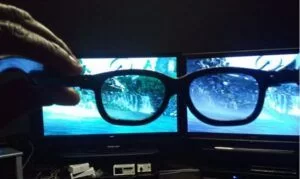When technology waved its magic wand the entire globe fell under its spell, witnessing a rapid change and innovation. Every innovation changed the lives of people for the betterment. Active 3d and passive 3d are technology emerged in order to make you see “in-depth” from a 3d perceptive.
Technically, we all know that the right side of our eye does not see things meant for the left eye. Hence active and passive 3d is the current and most commonly used method to view the image properly giving it a single image. These days you need not buy 3d glasses for the same at least for home use.
Even if you purchase a TV these days, most of them come with a 3d facility. Different brands use different 3d methods. The most commonly used 3d technology is active 3d and passive 3d. In this tutorial, we will go through some basic factors that differentiate the technology, their working methods, and benefits.
When talking about active 3d, these glasses are made of LCD shutter lenses that run on a battery. The active 3d lenses have the perfect coordination that automatically turns the glasses from opaque to transparent.
Hence to capture the 3d experience becomes quite easier. The stunning phenomenon of glass lens flickering at a speed of 120 times per second creates a viewable 3d image. Whereas, passive 3d works on the polarizing lens is very commonly used in theatres these days!
Here the working method is quite convenient and easy, the images are polarized through the passive glass lenses and all the images are shown to the eye at the same time without having to undergo any kind of flicker of the lenses. The best part is that the passive 3d does not require any kind of external power source like a battery.

Passive glasses are more lightweight and cheaper almost half the price of active glass. Passive 3d is now used in almost all TV brands giving you a perfectly high-quality 3d definition. The lenses in passive don’t flicker which makes it really comfortable for your eye and gives less eye fatigue.
One of the most important drawbacks of active glasses is that they are quite expensive and require an external power source.
The rapid flickering may cause discomfort to your eye. Active 3d was used in some of the TV brands but with the growing popularity of passive 3d, many prominent brands have switched from active to passive 3d.
Hence when comparing active vs passive 3d, passive 3d is on the higher side.
Some Important Factors That Need Attention When Comparing Active vs Passive 3D
Although we discussed the advantages of passive over active 3d, there are many advantages of both technologies. Both passive and active display has their uses and definite purpose.
But while purchasing TV brands you probably have to choose the one best suitable for you. When 3d was first introduced on TV, many brands like Panasonic and Samsung took the active 3d shutter glasses route. While brands like LG took passive 3d for their TV.
When you compare the image quality of active vs passive 3d, it is active 3d that provides excellent high definition clarity while passive provides an average, half-resolution high definition.
However, the compatibility of activity is low as the majority of glasses work only with the TVs from the same brand. The compatibility of passive is high as it uses the same system that is used in the theatres.

The brightness of passive 3d is better when compared to active and the reason for this is quite reasonable. The shutter mechanism in active 3d is one of the reasons as it causes a measurable reduction in light emission which provides a dimmer image.
In passive 3d we all know that polarizing filters affect t minimal light transmission process providing images that are bright and clear. When comparing active vs passive 3d both have definite advantages and disadvantages hence you need to opt for the one based on your requirement.
Where To Look For Active Vs Passive 3D Glasses
Purchasing them is however not at all a difficult task as they are available at all dedicated electronic stores and online retail stores as well. All you have to look for the one that fulfills your requirement while comparing active vs passive 3d before purchasing. Hope this tutorial proves beneficial for the reader and they get a fair idea about both the 3d glasses.
Many viewers ask, “Which one is the best in the competition of active vs passive 3d?” but the answer is simple, both have good as well as negative qualities, it depends on the viewer’s requirement and the extent of their usage. When I said “the extent of usage,” it says the time you spend watching TV or clearing speaking if you like watching 3d then passive is the better option.

Leave a Reply